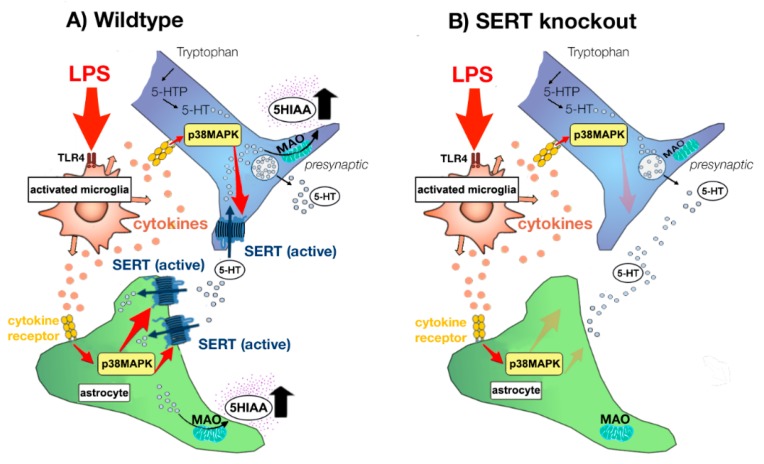Figure 3.
Model of regulation of serotonin (5-HT) transporter (SERT) activity after LPS challenge in SERT Wildtype (SERT+/+) rats and SERT Knockout (SERT−/−) rats. LPS via the binding to toll-like receptor 4 (TLR-4) on microglia produce its’ activation and consequently increase in the release of pro-inflammatory cytokines (e.g., IL-1, IL-6 and TNF-α). This increase in pro-inflammatory cytokines enhance SERT activity in neurons, as well as increase SERT gene expression in astrocytes. Both processes may be mediated by p38 MAPK-dependent pathways, despite the fact that also independent pathways have been suggested. After reuptake by SERT, 5-HT is packed in storage vesicles or metabolized by monoamine oxidase (MAO). In serotonergic neurons and astrocytes, MAO metabolizes 5-HT to 5-hydroxyindole acetaldehyde and thereafter aldehyde dehydrogenase rapidly metabolizes 5-hydroxyindole acetaldehyde to 5-hydroxyindolacetic acid (5-HIAA). Thereafter, 5-HIAA diffuses outside the cells. Thus, SERT plays, besides controlling the length of the cellular actions of 5-HT, an important role in the formation of its’ metabolite 5-HIAA. As a consequence, LPS-induced SERT activity results in enhanced 5-HT uptake into astrocytes and neurons and thereby promote 5-HT degradation to 5-HIAA in wildtype animals (A). Since SERT does not come to expression in SERT knockout animals, LPS cannot increase SERT activity and associated 5-HT metabolism in these animals (B), indicating that the SERT is involved in LPS-induced enhancement of 5-HT metabolism in male rats. (Figure adapted after Haase and Brown, 2015 [33]).

